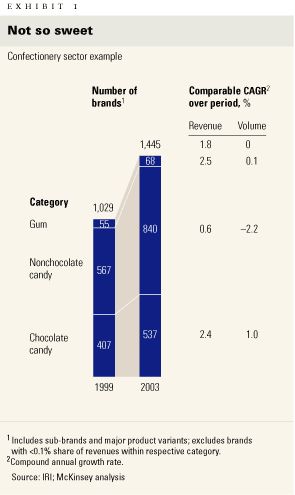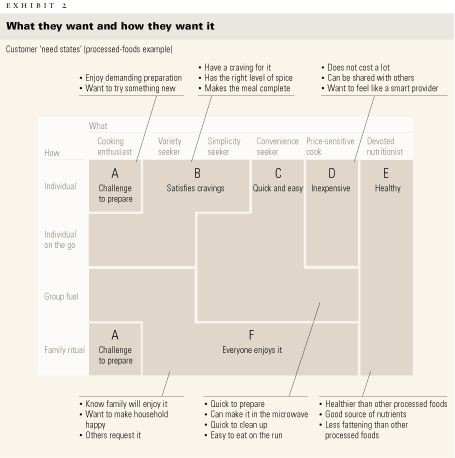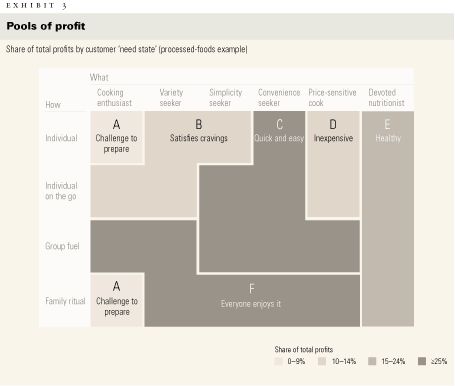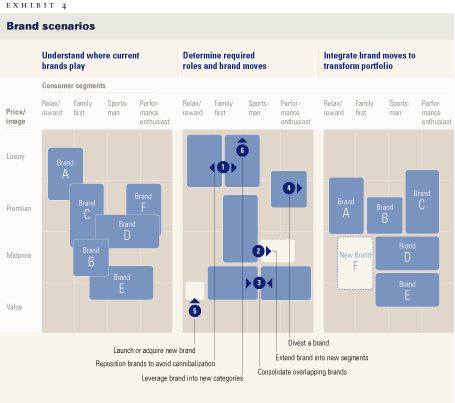In theory, at least, most marketers recognize that they should run their brands as a portfolio. Managing brands in a coordinated way helps a company to avoid confusing its consumers, investing in overlapping product-development and marketing efforts, and multiplying its brands at its own rather than its competitors' expense. Moreover, killing off weaker or ill-fitting parts of the product range—an important tenet of brand-portfolio management, though not one that should be applied at all times—frees marketers to focus resources on the stronger remaining brands and to position them distinctively. It thus reduces the complexity of the marketing effort and counteracts the decreasing efficiency and effectiveness of traditional media and distribution channels.
Theory, however, is one thing, practice another. Marketers today face heavy pressure to produce growth in an era of fragmenting customer needs. Understandably, they often react by expanding rather than pruning their brand offerings. After all, killing tired brands and curbing the launch of new ones isn't easy when the remaining portfolio must capture nearly half of a discontinued brand's volume merely to break even. Marketers also worry about the repercussions of using a portfolio approach and making the wrong call. Companies today are more likely to punish brand managers for missing an emerging opportunity than for failing when they try to exploit it.
For these and other reasons, brands (including sub-brands and line extensions) are proliferating at a breakneck pace in industries such as beverages, consumer durables, food, household goods, and pharmaceuticals.1 Among other ills, this explosion makes it harder to define customer segments and positioning objectives consistently. Consider, for example, the predicament of automakers that have stuffed their brand portfolios with dozens of all-too-similar sport utility vehicles. Discerning indeed is the consumer who can pick out meaningful differences among them. Costs reflect the profusion of brands as well, since companies with too many of them suffer from increased marketing and operational complexity and from the associated diseconomies of scale.
If marketers are to thrive, they must resist the compulsion to launch new and protect old brands and instead shepherd fewer, stronger ones in a more synchronized way. Anheuser-Busch, for example, uses a coordinated approach: it recognizes that customers shift to different beers (from lower- to higher-end or fuller to lighter brews, for example), and its portfolio strategy aims to keep those customers within its family of brands when they do so. Procter & Gamble has carried out a successful global rationalization over the past few years. And several other consumer goods companies have achieved rates of revenue growth two to five times higher than their historic norms and saved 20 percent of their overall marketing expenditures by managing their brand portfolios more effectively.
How do such companies do so? In part by establishing clear roles, relationships, and boundaries for their brands and then, within these guidelines, giving individual brand managers plenty of scope, subject to oversight from one person who is responsible for the portfolio as a whole. Top-down goals, such as P&G's recent desire to prune brands that aren't top-two performers in their categories, also play an important role—provided that the goals are informed by a deep understanding of consumer needs. In addition, since new portfolio strategies frequently prompt reactions from competitors and have unanticipated consequences, companies will have to change the organization to facilitate quick, coordinated responses for the portfolio as a whole and for individual brands. Robust metrics that highlight unexpected shifts are critical to both.
More brands, lower revenues

The portfolio problem
It's easy to see why marketers resist the portfolio approach to brands. After all, entrepreneurial brand managers, not portfolio managers, built most of the world's great ones, such as Tide (P&G) and Cheerios (General Mills), in the United States, and Persil (Henkel), in Europe. Even if most of these brands are part of portfolios today, a portfolio approach wasn't necessary when the pioneers were developing smaller numbers of brands.
But managing them has become more difficult, since companies in maturing sectors have not only used new brands and products to pursue continued growth but also resisted pruning existing ones, in hopes of maintaining market share, cash flows, and long-lived consumer franchises. Mergers, which became much more common during the 1980s and 1990s,2 compounded the problem. All too often, an acquisition motivated by the allure of a specific brand, such as PepsiCo's purchase of Quaker Oats to obtain Gatorade, also brought a legacy—from breakfast cereals like Cap'n Crunch to dinner favorites like Rice-A-Roni—that complicated the portfolio manager's task.
Although the search for growth provided the main impetus for launching new brands and sheltering old ones, most industries failed to achieve the desired result. In confectionery, for example, the number of brands increased by more than 40 percent in recent years, but overall revenue and volume haven't kept pace (Exhibit 1): most individual candy brands have a smaller market share than they did a few years ago. In addition, an ever-growing number of brands imposes complexity costs affecting the entire life cycle, from product development and sourcing (more R&D resources) to manufacturing and distribution (more labor schedules to coordinate) to sales and channel management (more training and more brands than the sales force can really focus on) to marketing and promotions (more documentation and more coordination of marketing vendors and agencies).
The demanding nature of the solution makes matters even more difficult: restoring order calls for centralization and restraint, both of which run against the grain of even the most sophisticated marketing organizations.3 Brand moves that look economically attractive or strategically tidy may founder because of the complex interrelationships between products and segments or a backlash from consumers. Volkswagen's impressive success at repositioning Seat and koda Auto, for instance, raised the bar for some of Volkswagen's core products, such as the Golf. Even Proctor & Gamble had to backtrack on its effort to replace Fairy dishwasher detergent with Dawn in Germany after its market share in dish soaps dropped to 5 percent, from 12 percent, in less than two years.
Crafting a portfolio strategy
To deal with the mess, companies need a flexible portfolio approach sensitive to consumers and current brands alike. While bold, top-down declarations of intent do have a place, marketers will be better served by first clarifying the needs that brands could satisfy and then assessing both the economic attractiveness of meeting them and their fit with the positioning of existing brands. Only then should marketers move to increase the portfolio's value by making strategic decisions on the restructuring, acquisition, divestiture, or launch of brands.
Start with the consumer
The starting point for marketers is to define categories as consumers do. Over the past decade or so, PepsiCo, for example, has recognized that customers choose among all nonalcoholic beverages, not just carbonated ones, to satisfy their need for refreshment. It has therefore made acquisitions (Gatorade, SoBe, Tropicana), developed new products (Amp, Aquafina), and completed several joint ventures (the one with Starbucks led to the bottled Frappuccino). Strong operating results have followed.4
Successes such as PepsiCo's—as well as Kellogg's winning move from breakfasts to nutritional minimeals and Procter & Gamble's repositioning of Olay from moisturizing products to all skin- and beauty-care offerings—result from a judicious, deliberate broadening of a company's frame of reference. The revised view of consumer needs is neither too narrow and category constrained nor too broad and conceptual. Moving gradually often helps companies to strike such a balance; PepsiCo, for instance, initially expanded its frame of reference from cola drinks to all carbonated beverages and only later moved into nonalcoholic, nondairy ones. The fit between the redefined frame of reference and existing organizational capabilities also provides a reality check. When an expanded frame of reference implies brand-extension opportunities that a company can't easily seize by itself, it must weigh the benefits of acquisitions or partnerships to broaden its portfolio against their complexity costs.
Within a given frame of reference, marketers need a disciplined way of evaluating their brands' opportunities. One is to scrutinize "need states"—the intersection between what customers want and how they want it (Exhibit 2). Many marketers think about need states from time to time, but most define their brands by product (for instance, an economy brand) or consumer segment (young adults, say) instead of consumer needs ("people consume this brand when they want something cheap, don't care about nutrition, and can't spend time cooking at home"). Although thinking through need states is demanding, it often suggests new ways for existing brands to satisfy the needs of customers, thereby helping marketers avoid the common trap of launching a new brand every time they want to enter a market.
Analyzing the customer's 'need states'

When a global brewer scrutinized the need states of its customers, for example, it discovered that there was no single "import" segment; a wide range of people bought imports across several need states. Such findings show that the "one brand per customer segment" approach can be mistaken. If the occasions when consumers use a product largely shape their needs, it is often appropriate to offer the target consumer a number of brands.
Balance economic opportunity with brand reality
Need states are more than descriptive tools: they also represent market opportunities. To evaluate them, marketers must begin by estimating their size. Since need states rarely coincide with conventional market definitions, it is often necessary to piece together known segment-share and channel-mix figures creatively. Category, consumer, product, and packaging trends can point to the likely future size of need states, and potential shifts in the intensity of competition can shed light on future profitability. The resulting profit pool map (Exhibit 3) reveals attractive opportunities for brands to target.
Mapping future profits through 'need state' analysis

But make no mistake: a profit map is no portfolio strategy. For starters, to target some seemingly attractive need states, it may be necessary to reposition brands so much that they no longer appeal to their original consumers. Such considerations help explain Toyota Motor's 1989 decision to launch Lexus as a separate brand and not as a new Toyota model. By contrast, Mazda Motor's much-praised Millenia luxury car struggled with its brand identity from introduction in 1994 until it was phased out in 2003.
To avoid positioning mistakes, marketers must understand each brand's unique contribution to the portfolio. Mapping its current brands against the universe of relevant need states is a helpful starting point. The most valuable insights often emerge when marketers use statistical tools and market research to assess the relationship between the things customers value in a given need state and the attributes that differentiate the brand for them.5 Combining this consumer knowledge with conventional metrics (such as each brand's market share within a variety of need states as well as the proportion of each brand's volume that a need state represents) helps clarify the attainable opportunities for each brand and the amount of differentiation or overlap within the portfolio.
Many companies mapping out their portfolios find that they have at least one relatively weak brand. Some choose to retain and improve underperformers rather than jettisoning them or targeting them toward new customers, but that approach carries risks. Frequently, companies that hold on to underperformers can't really support all of their brands and thus have to make small cuts in the resources allotted to each, thereby undermining the performance of their portfolios. One benefit of developing a profit map is that it helps catalyze more dramatic action by painting a clear picture of the economic opportunities companies forgo if they don't take the portfolio approach.
Make the tough choices
Marketers generally have two options for achieving their portfolio goals. First, they can restructure their brands by repositioning those that have lost relevance to the target segments, by consolidating two or more mature brands competing for the same consumers or by divesting a brand that absorbs more resources than it contributes and holds little promise of a turnaround. Restructuring doesn't involve pursuing customers whom a company doesn't currently serve; rather it means changing the brands that serve its present customers. The other option is to change the portfolio to drive new growth by launching a new brand, by acquiring or licensing one from another company, or by redefining an existing brand to target a new category of customers.
Restructuring is scary because it involves modifying brands and consumer attitudes. But though careful management is certainly needed to restructure brands without losing customers, the risk of adding new brands or categories is often greater—and so are the investments. Value-creating brand acquisitions are few and far between. Roughly three-quarters of all new brands fail. And stretching brands into any new category is risky because it's easy to go too far and lose their identity. Brand managers are accustomed to making headlines through launches or acquisitions, but those tactics are usually the last to consider for a portfolio strategy.
Of course, companies can rework their brand portfolios in a number of ways, which are often interconnected—if one brand is repositioned, that may have ripple effects for others—so it isn't practical to evaluate each brand move in isolation. Marketers must therefore develop and compare a manageable number of plausible scenarios that bundle compatible moves. Each scenario should involve only a few of them (Exhibit 4); more than four or five can overwhelm a marketing organization and confuse consumers. To define those moves, a company must make decisions about issues such as the right number of brands—and which to have—and the advisability of offering umbrella brands with sub-brands beneath them rather than a medley of individual ones.
Adjusting a brand portfolio through carefully defined moves

Several rules of thumb help marketers to avoid playing a trial-and-error game. First, they can build their strategies around leading brands. If well-known ones are financially successful, their role in the portfolio shouldn't change much, but when they underperform it's critical to adjust their positioning before recrafting the roles of other brands. Second, marketers must ensure that their sophisticated and ambitious portfolio ideas are feasible in view of internal resource constraints and likely competitive reactions. Finally, they should know when a brand is the consumer's second choice. Research techniques such as conjoint analysis can help them learn whether two or more adjacent brands are taking share and margins from each other or from competitors.
For an international industrial-equipment manufacturer, building the portfolio around a leading global brand has been a straightforward affair in many markets but problematic where the company's other brands are powerful leaders. In those countries, the company makes styling adjustments and includes features valued locally even though they increase the complexity of its offerings. It also found that in some markets, it sold similar products for different prices. The resulting cannibalization—people usually bought the cheaper offering—was costly. By clarifying brand roles, making local adjustments when necessary, and doubling the number of shared parts in products, the manufacturer has raised its portfolio sales by 3 percent in a stagnant market and cut its development costs by up to 5 percent.
Managing the portfolio
Getting strategy right is only part of the battle; companies must also make organizational changes if they are to adapt their brand portfolios quickly to shifting trends, competitive responses, mergers, and new-product launches while also managing the natural life cycle of their brands. Since taking action with one often means doing so with another, companies must appoint a dynamic portfolio manager who can ensure that the whole portfolio moves nimbly.
How can a company centralize this kind of authority without handcuffing the managers of its individual brands? That depends largely on how it constitutes the portfolio manager's role. The crucial thing is that the person who holds it must have the ability to determine, on an ongoing basis, how well individual brands are fulfilling their part in the portfolio strategy and whether the strategy itself still makes sense. The portfolio manager must, of course, have certain traits and skills. But much will also be required of the organization, including unity of purpose across functions and businesses and robust metrics for tracking performance.
Structural options
To articulate and monitor a brand-portfolio strategy, the portfolio manager must have the authority, the marketing skills, the facts, and the analyses to sway the brand managers. Sometimes the chief marketing officer, the vice president for marketing, or a person who rose through the ranks of the marketing organization and then became general manager of a business unit can serve as portfolio manager while still carrying out his or her primary duties. The support team might consist primarily of "swing" analysts who have some responsibility for individual brands but can be called up by the portfolio manager for major events, such as a new-product launch or the acquisition of several brands. At the extreme, brand teams might have a fluid membership.
In other cases—particularly in industries characterized by rapidly changing tastes (fashion), many sub-brands (autos), or rapid consolidation—a full-time portfolio-management structure may be warranted. One global automobile manufacturer relies on a central organization to coordinate its brand strategy. Pricing is one key area of focus because although each of the portfolio's car lines has a specific role that its list price reflects, differences in base features and functions make apples-to-apples comparisons difficult. The central team gets around this problem by creating "virtual" cars with identical features across brands, setting the value of each brand according to its role in the portfolio, and then building in or stripping out standard features to arrive at real pricing.
Essential tasks
Whatever structure a company selects, it is vital for the portfolio manager to channel the entrepreneurial energies of the brand managers in the right direction and, when necessary, to make them trim their sails or change course.
Building agreement. The portfolio manager must get individual brand groups to endorse the portfolio strategy formally. Incentives that reward them for the whole portfolio's performance help to ensure that they don't revise their brands' strategies when no one is watching.
Meanwhile, the portfolio manager should reconcile the portfolio strategy with functional agendas elsewhere in the company. It might, for example, be necessary to set up focused R&D initiatives to fill gaps in the brand portfolio, to work with the finance organization to include key brand metrics in annual and long-range plans, and to have the sales organization develop a calendar and resource-allocation guidelines. The calendar would be linked to key dates in the strategy's rollout, and the guidelines would include directions for presenting brands to intermediaries such as grocery stores or car dealers.
Tracking progress. Measuring whether each brand is fulfilling its role in the portfolio is crucial. Standard metrics show whether consumers know about, have tried, or ever considered purchasing a brand; their attitudes toward it (for instance, is it "worth paying more for?"); rates for converting prospects into customers and for retaining customers in target segments; and levels of customer satisfaction. Other metrics should be tailored to the strategic goals for each brand. If the managers of several brands in the same portfolio track identical metrics, the company often has a problem: either the metrics are at too high a level to shed light on the relative performance of different brands, or the brands are positioned so closely together that the strategy needs a rethink.
An appliance maker introducing a new, lower-priced line to its portfolio, for example, found it helpful to track product-mix changes by sales channels. It discovered that in some of them, its existing premium products were positioned close to the new line, a problem that leads to cannibalization and falling margins. This timely channel data prompted the company to stop the bleeding quickly. Well-conceived metrics also clarify major competitive moves. In the value end of the appliance industry, for instance, LG Electronics and Samsung have made advances that are prompting several other manufacturers to rethink the role of value offerings in their own portfolios.
Although the annual planning process is a natural time for such dialogues, brand managers should raise red flags whenever these issues appear, particularly if the portfolio manager's likely response to them includes adding a brand. When market researchers recognize a new consumer trend, the portfolio manager must get involved to avoid a familiar outcome: a number of similar products for similar customers and need states.
Marketers are uneasy about rigorous brand-portfolio management, but overcoming this mind-set can pay big dividends. For companies that succeed, setting the portfolio strategy isn't a onetime event; it's a living, breathing part of day-to-day business.
